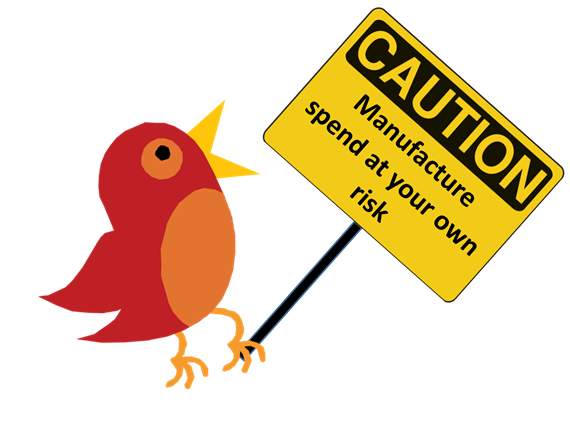Note: As of October 13, 2015, the Target REDcard (REDbird) can only be loaded with cash in-store at Target. Gift cards and/or debit cards no longer work to load REDcard. For more info, see: Here is the REDbird memo, “Cash is the only tender guests can use”
As of May 6, 2015, Target no longer accepts credit cards for in-store REDbird reloads. For more information, please see “REDbird Post Memo Answers“, and “REDbird grounded. Now what?“
Earlier this week I published “Manufacturing spend: What’s safe?” That post focused on ways to avoid getting shut down by banks and other credit card issuers when manufacturing spend. In response to that post, a number of people asked specifically what is safe with regards to the Target Prepaid REDcard, AKA REDbird. The question is usually focused on how to avoid credit card shut downs. The fear is that frequent high dollar REDbird loads paid for with a single credit card will be looked at unkindly by the credit card issuer. Another topic with regards to REDbird safety, though, is how to avoid getting your REDbird card shut down. This has become especially interesting since some people have reported that their accounts have been shut down (see “Real or hoax? Your Target Prepaid REDcard Account has Been Closed”).

Quick background
The Target Prepaid REDcard is a reloadable prepaid Amex card that is so similar to another Amex product, Bluebird, that many have taken to calling it REDbird. One feature that makes REDbird particularly appealing is that most Target stores allow reloading the card with a credit card, for free. And, those credit card reloads always count as purchases by credit card issuers. This means that REDbird reloads can be used to meet minimum spend requirements, earn credit card rewards, and meet big spend bonus requirements. Once money is loaded, the card can be used as an Amex credit card, or as an ATM card for cash withdrawals, or to pay bills online, or simply to withdraw money back to your bank account. Reloads are limited to $1,000 per transaction, $2,500 per day, and $5,000 per calendar month. Even though each person can only have one REDbird card in their own name, many people manage more than one card thanks to spouses, friends, or relatives who allow them to use their accounts. In this way, it is possible to exceed the $5,000 monthly limits. More information can be found in the posts listed at the bottom of this article.
Author disclaimer
As I wrote in the previous post on manufacturing spend safely, I don’t really know what is safe and what is not. I don’t work in the banking or prepaid card industry. I have no inside knowledge of… anything. So, for those who don’t mind taking advice from someone who knows almost nothing about this subject, what follows are my best guesses as to what is safe…
Credit card safety
There are a few reasons why a credit card issuer may shut down accounts with heavy REDbird reload activity. One is that they may consider you a bad credit risk. If you regularly load more to REDbird each month than you earn (based upon the salary and other income information you gave when applying for your credit card) or suddenly spend much more than you have before, the card issuer may fear that you won’t always be able to pay back that much money. This risk can be ameliorated by spreading load payments across multiple cards from different card issuers. It may also help to pay off your balance mid-stream to keep the card issuer’s overall exposure low at any given time.
Another potential issue is “perk abuse”. If you have a card that offers a grocery store bonus, and if the Target store you load at is coded as a grocery store, you will likely cost the card issuer a lot more (in the form of rewards) than they earn in transaction fees. In those cases, a guideline I’ve proposed is to limit the card issuers losses to $2,500 per year, or less. With a card that offers 5% cash back at grocery stores, that means a limit of $50,000 “grocery” spend per year.
Another issue is that frequent round number charges at Target (e.g. $1000, $1000, then $500) may simply look suspicious to your card issuer. One solution is to mix up the load amounts. For example, rather than loading $1000 at once, you could load $672 at one time, and $328 another time. Personally, I would find that difficult to manage. An option I far prefer is to buy Amex gift cards online (and get cash back) and then use those gift cards to reload REDbird. In this way, the credit card issuer will see only one large Amex gift card purchase at a time and will have no way of knowing (or caring) about your in-store reloads. For details about Amex gift cards, please see: The complete guide to Amex gift cards.
Keeping REDbird alive
It is extremely common for prepaid card companies to shut down accounts of those who use the products “not as intended.” I first experienced this in 2012 when my NetSpend card was shut down (details here) and, since then, I’ve had similar experiences with GoBank, Mio / My Vanilla, and PayPal (and I’m sure I’m forgetting about others!). The only prepaid company that hasn’t shut down any of my accounts has been American Express. That said, it is perfectly reasonable to expect that Amex will examine your account sooner or later… To reduce the chance of having your REDbird account closed, I recommend the following practices:
- Always keep a balance on your REDbird account. After all, you never know when you’ll need it to buy stuff at Target (and get 5% off).
- Use the card often at Target and/or Target.com for regular purchases.
- Let time elapse between loading and unloading your account. A week or two should suffice.
- Unload via a combination of bill pay, ATM withdrawals, and withdrawals to your bank account. Make bill pays in realistic amounts. Do not unload the exact amount you recently loaded.
- Do not bill pay the same credit card that was used to reload REDbird. I have yet to see any evidence that bill paying the credit card used for the reload is a real issue, but you never know.
- Consider using the card for some regular spend outside of Target as well.
- When loading online via debit card, use only a real bank debit card. While it may be possible to occasionally sneak in a prepaid debit card, doing so is very likely to get your account flagged.
Read more about REDbird:Also: |
|---|





[…] will switch to Redbird, abuse the card and cause a mass shut down. Hopefully people will heed Frequentmiler’s advice on how to avoid Redbird shut-downs and we’ll all be […]
got a card from someone and they loaded $1. Now I am going to Targets in NC and I’m not allowed to load. 3 different stores have not been able to do it? Any suggestion or is this now the norm?
Unfortunately REDbird simply doesn’t work in North Carolina. I think you’re out of luck until Target fixes the issue
Purchased temp card at Target today – loaded with $500.
Went to register the card online tonight. First page accepts the card number, CSV number, and birthday. Next page includes a welcome message with the $500 balance and other info pre-populated. But as soon as I enter in my PIN, email, and password and click submit, I’m getting an error message that “CSV 4 DOESNT MATCH TEMP CARD.” Yet, the system already allowed me to get the page in question by matching my CSV to the card number. Customer Service isn’t being too helpful.
Ever heard of this?
No, that’s a new one to me. Anyone else?
Try this number to get better help: 800-438-6468
You are not the only one who has gotten that error message. They are receiving a lot of calls regarding this issue.
I called the number on the back of the card today 3/9/15 @ 12:30 and 5:00pm and the customer service rep informed me they are having a System wide glitch on their website and their IT department is working on resolving the issue. I was told they will have the glitch fixed within the next 24-48 hours and to register your card after that timeframe.
I’m getting same error. I already have active redbird but I tried to register one for my dad, not working.. Im sure all the Redbirds sold on eBay loaded with $1 are giving same error message.. Lol i think he only solution is to let same person registering online buy the temp. Card with his details. Looks like the loophole has been closed..
I called them today again, and the service rep said they still haven’t resolved the issue and the IT department is still working on it. When I pressed them for more details the rep said they think it is a batch of cards that have the wrong CSV4 code not matching up and it is hit or miss right now. I asked if I should buy a new one and she told me not to and to just try registering it again tomorrow. I think they are tying to close the loophole but haven’t managed to do it for all cards as of yet. We shall see in the next few days and weeks to come. In any case, this is not good news. 🙁
I have the same problem. I called them today and they said I have to try it again in 3-4 hours and it should work. Well that’s what they said couple days ago to try it again in 24 hrs but still not working even after 3 days. Let me know if anybody have a solution to this.
I succeeded in registering on web after 3 today.
I had the same error show on one of the two cards I bought (the error occurred on the second card that I tried registering).
I attempted three days in a row, still the same error. Yesterday afternoon, I attempted registering on my iPhone (instead of desktop), and it worked. However, I still have not received an email so that I can verify the account (even after hitting ‘resend’ a few times). I plan on calling later today to resolve this issue.
It works now..
A strange thing happened last night at my local Target… I went in to reload my REDcard prepaid Amex… and the manager behind the service desk said:
He said:
“We’re not accepting pre-loads at this store. The prepaid card has been in a trial period, and we’ll know by the end of the week whether it will be continued or not.”
Sounds to me like a misinformed employee
*sigh* I figured that the abuse of REDbird would slowly kill it’s usefulness before it ever hits California.
That’s why you gotta go to ebay and get your card. It’ll cost you $30.00 but you will make that up in the first month. No one knows when Target will roll this card out nationwide or when they may rescind CC loading so take advantage of this perk while it still exists.
I usually load $2k-$3k a month and use bill pay to pay off the card used to make the load. Last night I tried to withdraw via the ATM, but I noticed that you could only withdraw $400. I also kept getting an error when trying to view the balance via the ATM (I had just bought stuff at Target and didn’t know the exact amount in my Redcard account). Am I missing something? Do you have to withdraw “as a credit card” rather than the checking or savings option?? Also can you do multiple withdrawals of $400?
Per wiki: ATM Withdrawals – $750/day and $2,000/month.
$400 is ATM’s own limit
I don’t think any activity is safe for an MSer who maxes out $5000 load each month. Regardless of whether they shop at Target for some groceries or not is beside the point. The target customers of amex for this product are unbanked people who don’t load $5000 into their account either 2 times a month or more. The true unbanked usually don’t have that much and they don’t have CCs to load even one RB; many have also posted having several RBs they’re maxing out each month.
There is nothing you can do to get your Redbird or Bluebird shut down. Amex makes money off of these products and after losing their exclusive service to Costco (someone quoted it was valued at 80 million annually) they are happy to have partners like Walmart and Target. The risk is from the CC that you load with, as most of them have the rules about cash like products, perk abuse, and such. Personally I have been buying an extra item or two and loading the card in the same transaction. This gives you a total over $1000 with odd numbers that look like different purchases, instead of a round $1000 over and over. I agree that unloading at atm right after making a load is not good thinking, but using atm or bank transfer are legitimate uses of the card and if they didn’t intend you to use those features they shouldn’t offer them. The sky is not falling, go back to your business.
Good observations, thanks!
I gotta ask.. How does that CC issuer see buying AMEX gift cards for $X amount (or even larger) is any different than spending the very same $X at Target? If you are buying AMEX GC, does not the bank know explicitly what you just bought?
The difference is that with Amex gift cards, you’ll have one large purchase. For example, if you buy 3 $2000 cards, you’ll have one big purchase for over $6000 (since the purchase will include card fees). Going to Target directly and using round numbers, the same $6000 would show up on your credit card as something like (depending on how you do the loads):
Target $1000
Target $1000
Target $500
Target $1000
Target $1000
Target $500
Target $1000
My thought is simply that having many repeated big even number purchases at Target is much more suspicious looking than one large Amex gc purchase.
Follow
Been loading and unloading via BP the amounts loaded for over 1.5 years and no issues with BB and been doing it with RBs for a couple of months. I do not like to leave the large amounts in Prepaids cause if they shut you down, than that money is tied up for a couple of months. No matter how you look at it, it will be a lost for Target on RB. If they are going to shut you down, they will and I don’t feel those things mention above will really matter. It’s just a matter of time before CC loads will end at Target.
Agree 100%. These feeble attempts to “guess” at safe limits are ridiculous and way below this bloggers bs line. I guess he had no column for today…go back to work FM
simple – use, don’t abuse.
In addition to those good suggestions (some of which I already do — like buy stuff at Target), I am also thinking of adding some money to my account via my checking account today (maybe $50 or $100) and perhaps doing that every month. Maybe good for them to see an account having something more than cash reloads? Can’t hurt, right? Definitely getting our 3 cards out today and going to buy something small on each of them.
I am better than my husband at letting time elapse before I pay bills and not withdrawing the exact amount (he likes to just load and dump into his bank account), so I will be interested to see whose gets shut down/shut down first!